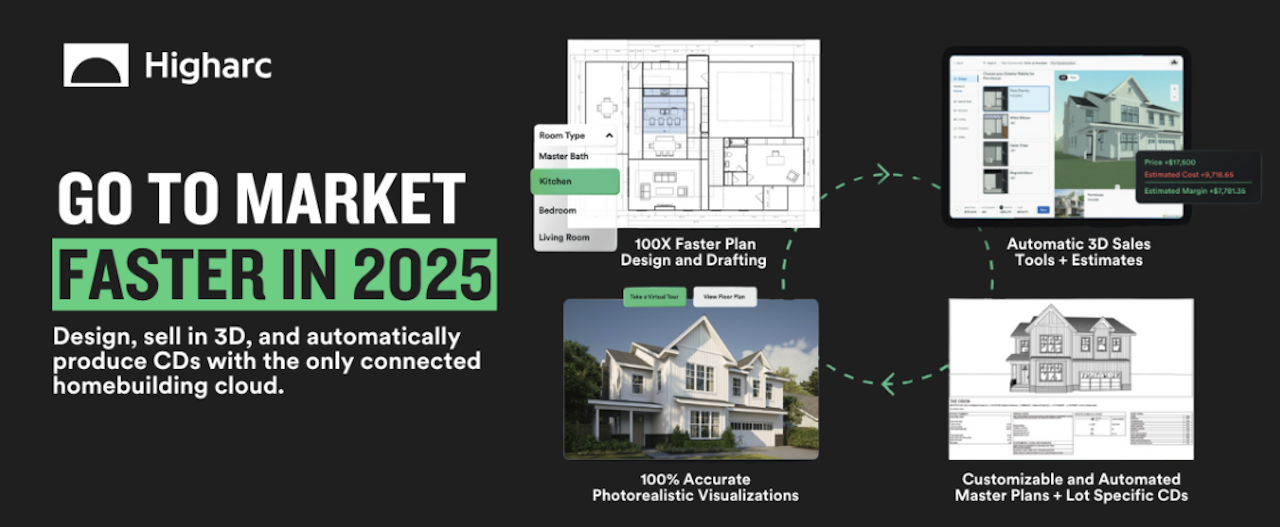Technology
Design-Estimating Disconnects Cost Builders Time And Margin
Former builder-operators Brandon Pearson and Marcus Gonzalez share what’s broken—and how connected teams can win now and in 2030.

The refrains in today's market speak for themselves.
It takes us as long to sell a home in this market as it does to build it to ready-to-own fit and finish," one CEO of a mega-regional privately-owned homebuilding enterprise tells us.
Another lament from the high-level strategic trenches goes like this:
Even if the Fed starts to pivot on its funds rate, how is a slightly lower 30-year-fixed rate going to make any difference in sales rates when we've already been buying down our customers' rate to 4% or so?"
In a homebuilding market gripped by hesitation, margin pressure, and the looming weight of a high-cost, high-risk future, one operational principle is gaining sharper definition by the day: complexity and opacity in workflows are no longer survivable liabilities—they're death traps.
At the junction where architectural design and estimating meet—if they meet at all—homebuilders often bleed dollars, time, and customer trust. That’s the crux of a plainspoken, highly practical conversation with Brandon Pearson and Marcus Gonzalez, two former builder-side operators now applying their experience in solution-focused roles at Higharc.

Pearson, a Solutions Consultant, and Gonzalez, Builder Partnerships Lead, are helping homebuilders not only cope with but capitalize on today’s market volatility by connecting dots that have too long lived in silos.
You want to move buyers off the sidelines without destroying your margin?” says Gonzalez. “Then you better start by knowing — really knowing—your costs down to the board, the brick, the wire.”
The Margin Squeeze and the Silo Trap
In today’s "race-to-the-bottom" environment—where deep-pocketed nationals slash prices and dangle aggressive buydowns—smaller, private builders are under pressure to find every operational edge. That edge, Gonzalez and Pearson argue, starts with addressing the chronic disconnect between design and estimating.
Builders are hesitant to adopt new designs, not because they don’t want to innovate, but because of everything that happens after the design phase,” says Gonzalez. “You’re talking delays, unknown costs, miscommunication—it becomes a bottleneck that no one has time for.”
The go-to workaround? Recycle tried-and-true plans.
We had 100 plans to choose from," he recalls of his years managing large master-planned communities. "But I’d just pull the 25 we already knew. Sales knew them, construction knew them—it was safe. We sacrificed innovation for speed and predictability."
Pearson agrees.
When the design team makes a change, the first question is, what’s the cost impact? And if you can’t answer that instantly, you’re stuck. You guess. You rely on heuristics—‘$12 a square foot’—which are outdated. And now you’re designing blind.”
PDF Plans Are Killing You
Both experts point to a fundamental flaw in how most homebuilders still operate: construction documents that are static, manually edited, and disconnected from real-time data.
Architects draw for architects. Purchasing builds from those drawings. They’re not speaking the same language,” Pearson says. “You’ll get Elevation A drawn as a full plan, but Elevations B, C, and D are just fragments. You can’t do a full takeoff. You can’t trace. You’re dead in the water.”
Even more maddening: architects may draw a window that looks 7 feet long but call it a standard 3050 in the annotation.
It’s a note on a PDF, not a data field. That breaks the estimating process immediately.”
The result? Expensive takeoff errors, rework in the field, and unprovable waste.
I’ve seen 20 sheets of drywall left over on a job,” says Gonzalez. “You know you're paying for it. But it’s turnkey, so there’s no line item to challenge.”
Lump Sum vs. Itemized: A Builder’s Crossroads
Both Pearson and Gonzalez believe the time is now for builders to move from lump-sum turnkey models to itemized estimating.
When you’re itemized,” says Pearson, “you’re nimble. You know exactly how many sheets of drywall or 2x4s you need. That gives you leverage—not just over cost, but over time. You can pivot your product strategy in days, not weeks.”
And in a market where some builders are shifting from entry-level to move-up or 55+ product to chase less rate-sensitive buyers, that kind of speed is make-or-break.
Itemization also breaks the dependence on a single trade partner,” adds Pearson. “You’re not stuck waiting for their bid. You can go to any supplier and say: how much for this unit? Can you deliver tomorrow?”
It’s a vision that’s become reality through Higharc’s integrated platform, which embeds dynamic metadata directly into designs.
You’re not trying to retrofit a plan into an estimate,” says Gonzalez. “The plan is the estimate.”
Trust, Culture, and Change Management
Still, tools only go so far without cultural change.
Most builders I’ve worked with—especially big ones—still operate in silos,” says Gonzalez. “You could walk into some of them today, and the drafter and the purchasing manager have never met.”
That lack of collaboration not only causes errors, it corrodes trust.
The default when something goes wrong in the field? ‘Takeoff error.’ Doesn’t matter what really happened,” says Gonzalez. “It’s a code. It gets used over and over. And it’s not fair—to the team or the process.”
The better path, both men say, is to build workflows that are connected from the first sketch through the final CO. That means integrated design, estimating, and marketing teams. It means sales gets updated flyers the moment a window spec changes. It means field supers don’t get stuck deciphering redlines that are weeks—or months—behind the design.
Pearson explains:
When we connect teams at the very beginning—architecture, purchasing, sales, construction—you get proactive instead of reactive. That’s the difference between thriving and just surviving.”
The Underrated Upside: People Do Their Best Work
An unexpected but powerful outcome of integrated workflows? People enjoy their jobs more.
Purchasing folks didn’t get into this to chase rework or correct a window schedule,” Pearson says. “They want to analyze, to optimize. Architects want to design—not update plan sets. When you cut the grunt work and give teams tools to collaborate, morale goes up.”
And that shows up on the bottom line.
When teams start celebrating wins together, rather than pointing fingers, you get better retention, better execution, and ultimately, a better customer experience.”
So What Needs to Change?
In a lightning round to close the conversation, Gonzalez and Pearson are clear: the barrier isn’t technology—it’s mindset.
Construction loves saying, ‘This is how we’ve always done it,’” Pearson says. “But if you show them something that’s easier, more accurate, and faster, they’ll listen.”
For Gonzalez, it’s about debunking the myth that change takes forever.
With Higharc, we’ve seen builders go from PDF to integrated, dynamic estimating in weeks—not years. That’s speedboat-level transformation, not aircraft carrier.”
Strategy Vs. Tactics
For homebuilders trying to stay afloat in this volatile market—and hoping to position for a more efficient, margin-smart, and customer-ready future—the message is clear.
If you still treat design and estimating as separate disciplines, you’re leaking money. You’re wasting time. And you’re handing the competitive advantage to someone else.
The winners—now and in 2030—will be those who build from a single, connected source of truth. A product vision that’s estimable. A takeoff that’s design-intelligent. A team that’s unified. And a customer who, for once, gets exactly what they were promised.
In this business, that's how trust is earned—and margins are kept.
MORE IN Technology
Pre-Development Is Where Velocity Happens: Here's How
In a high-cost, high-risk market, developers and builders must find every dollar and day they can save. Integrated digital pre-construction tools are quietly delivering outsized impact — if you know where to look.
The Future-Proof Homebuilder Operates A Unified Workflow
Hyphen Solutions CEO Felix Vasquez lays out why fragmented workflows are dragging builders down—and how connected data streams can turn the tide.
How Tim O’Brien Homes Is Re-Wiring Its Buyers' Experience
In a market defined by hesitation, speed and certainty separate survivors from stragglers. Tim O’Brien Homes shows how technology can deliver both.


